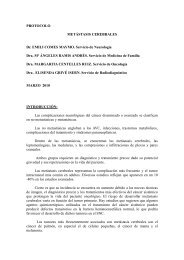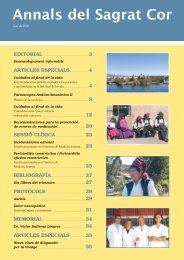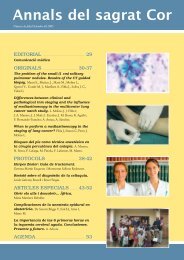- Page 3 and 4:
Monografías Hospital Sagrat Cor GU
- Page 5:
GUÍAS DE ACTUACIÓN EN LA PRÁCTIC
- Page 8 and 9: GUÍA DE ACTUACIÓN EN LA PRÁCTICA
- Page 10 and 11: GUÍA DE ACTUACIÓN EN LA PRÁCTICA
- Page 12 and 13: GUÍA DE ACTUACIÓN EN LA PRÁCTICA
- Page 14 and 15: GUÍA DE ACTUACIÓN EN LA PRÁCTICA
- Page 16 and 17: GUÍA DE ACTUACIÓN EN LA PRÁCTICA
- Page 18 and 19: GUÍA DE ACTUACIÓN EN LA PRÁCTICA
- Page 20 and 21: GUÍA DE ACTUACIÓN EN LA PRÁCTICA
- Page 22 and 23: GUÍA DE ACTUACIÓN EN LA PRÁCTICA
- Page 24 and 25: GUÍA DE ACTUACIÓN EN LA PRÁCTICA
- Page 26 and 27: GUÍA DE ACTUACIÓN EN LA PRÁCTICA
- Page 28 and 29: GUÍA DE ACTUACIÓN EN LA PRÁCTICA
- Page 30 and 31: GUÍA DE ACTUACIÓN EN LA PRÁCTICA
- Page 32 and 33: GUÍA DE ACTUACIÓN EN LA PRÁCTICA
- Page 34 and 35: GUÍA DE ACTUACIÓN EN LA PRÁCTICA
- Page 36 and 37: GUÍA DE ACTUACIÓN EN LA PRÁCTICA
- Page 38 and 39: GUÍA DE ACTUACIÓN EN LA PRÁCTICA
- Page 40 and 41: GUÍA DE ACTUACIÓN EN LA PRÁCTICA
- Page 42 and 43: GUÍA DE ACTUACIÓN EN LA PRÁCTICA
- Page 44 and 45: GUÍA DE ACTUACIÓN EN LA PRÁCTICA
- Page 46 and 47: GUÍA DE ACTUACIÓN EN LA PRÁCTICA
- Page 48 and 49: GUÍA DE ACTUACIÓN EN LA PRÁCTICA
- Page 50 and 51: GUÍA DE ACTUACIÓN EN LA PRÁCTICA
- Page 52 and 53: GUÍA DE ACTUACIÓN EN LA PRÁCTICA
- Page 54 and 55: GUÍA DE ACTUACIÓN EN LA PRÁCTICA
- Page 56 and 57: GUÍA DE ACTUACIÓN EN LA PRÁCTICA
- Page 60 and 61: GUÍA DE ACTUACIÓN EN LA PRÁCTICA
- Page 62 and 63: GUÍA DE ACTUACIÓN EN LA PRÁCTICA
- Page 64 and 65: GUÍA DE ACTUACIÓN EN LA PRÁCTICA
- Page 67 and 68: ENFERMEDADES INFECCIOSAS SÍNDROME
- Page 69 and 70: ENFERMEDADES INFECCIOSAS La elevaci
- Page 71 and 72: ENFERMEDADES INFECCIOSAS Los hemocu
- Page 73 and 74: ENFERMEDADES INFECCIOSAS cetamol a
- Page 75 and 76: ENFERMEDADES INFECCIOSAS INFECCIONE
- Page 77 and 78: ENFERMEDADES INFECCIOSAS En pacient
- Page 79 and 80: ENFERMEDADES INFECCIOSAS MARSA Aisl
- Page 81 and 82: ENFERMEDADES INFECCIOSAS inicial 18
- Page 83: ENFERMEDADES INFECCIOSAS (Meropenem
- Page 86 and 87: GUÍA DE ACTUACIÓN EN LA PRÁCTICA
- Page 88 and 89: GUÍA DE ACTUACIÓN EN LA PRÁCTICA
- Page 90 and 91: GUÍA DE ACTUACIÓN EN LA PRÁCTICA
- Page 92 and 93: GUÍA DE ACTUACIÓN EN LA PRÁCTICA
- Page 94 and 95: GUÍA DE ACTUACIÓN EN LA PRÁCTICA
- Page 96 and 97: GUÍA DE ACTUACIÓN EN LA PRÁCTICA
- Page 98 and 99: GUÍA DE ACTUACIÓN EN LA PRÁCTICA
- Page 100 and 101: GUÍA DE ACTUACIÓN EN LA PRÁCTICA
- Page 102 and 103: GUÍA DE ACTUACIÓN EN LA PRÁCTICA
- Page 104 and 105: GUÍA DE ACTUACIÓN EN LA PRÁCTICA
- Page 106 and 107: GUÍA DE ACTUACIÓN EN LA PRÁCTICA
- Page 108 and 109:
GUÍA DE ACTUACIÓN EN LA PRÁCTICA
- Page 110 and 111:
GUÍA DE ACTUACIÓN EN LA PRÁCTICA
- Page 112 and 113:
GUÍA DE ACTUACIÓN EN LA PRÁCTICA
- Page 114 and 115:
GUÍA DE ACTUACIÓN EN LA PRÁCTICA
- Page 116 and 117:
GUÍA DE ACTUACIÓN EN LA PRÁCTICA
- Page 118 and 119:
GUÍA DE ACTUACIÓN EN LA PRÁCTICA
- Page 120 and 121:
GUÍA DE ACTUACIÓN EN LA PRÁCTICA
- Page 122 and 123:
GUÍA DE ACTUACIÓN EN LA PRÁCTICA
- Page 124 and 125:
GUÍA DE ACTUACIÓN EN LA PRÁCTICA
- Page 126 and 127:
GUÍA DE ACTUACIÓN EN LA PRÁCTICA
- Page 128 and 129:
GUÍA DE ACTUACIÓN EN LA PRÁCTICA
- Page 130 and 131:
GUÍA DE ACTUACIÓN EN LA PRÁCTICA
- Page 132 and 133:
GUÍA DE ACTUACIÓN EN LA PRÁCTICA
- Page 134 and 135:
GUÍA DE ACTUACIÓN EN LA PRÁCTICA
- Page 136 and 137:
GUÍA DE ACTUACIÓN EN LA PRÁCTICA
- Page 138 and 139:
GUÍA DE ACTUACIÓN EN LA PRÁCTICA
- Page 140 and 141:
GUÍA DE ACTUACIÓN EN LA PRÁCTICA
- Page 142 and 143:
GUÍA DE ACTUACIÓN EN LA PRÁCTICA
- Page 144 and 145:
GUÍA DE ACTUACIÓN EN LA PRÁCTICA
- Page 146 and 147:
GUÍA DE ACTUACIÓN EN LA PRÁCTICA
- Page 148 and 149:
GUÍA DE ACTUACIÓN EN LA PRÁCTICA
- Page 150 and 151:
GUÍA DE ACTUACIÓN EN LA PRÁCTICA
- Page 152 and 153:
GUÍA DE ACTUACIÓN EN LA PRÁCTICA
- Page 154 and 155:
GUÍA DE ACTUACIÓN EN LA PRÁCTICA
- Page 156 and 157:
GUÍA DE ACTUACIÓN EN LA PRÁCTICA
- Page 158 and 159:
GUÍA DE ACTUACIÓN EN LA PRÁCTICA
- Page 160 and 161:
GUÍA DE ACTUACIÓN EN LA PRÁCTICA
- Page 162 and 163:
GUÍA DE ACTUACIÓN EN LA PRÁCTICA
- Page 164 and 165:
GUÍA DE ACTUACIÓN EN LA PRÁCTICA
- Page 166 and 167:
GUÍA DE ACTUACIÓN EN LA PRÁCTICA
- Page 168 and 169:
GUÍA DE ACTUACIÓN EN LA PRÁCTICA
- Page 170 and 171:
GUÍA DE ACTUACIÓN EN LA PRÁCTICA
- Page 172 and 173:
GUÍA DE ACTUACIÓN EN LA PRÁCTICA
- Page 174 and 175:
GUÍA DE ACTUACIÓN EN LA PRÁCTICA
- Page 176 and 177:
GUÍA DE ACTUACIÓN EN LA PRÁCTICA
- Page 178 and 179:
GUÍA DE ACTUACIÓN EN LA PRÁCTICA
- Page 180 and 181:
GUÍA DE ACTUACIÓN EN LA PRÁCTICA
- Page 182 and 183:
GUÍA DE ACTUACIÓN EN LA PRÁCTICA
- Page 184 and 185:
GUÍA DE ACTUACIÓN EN LA PRÁCTICA
- Page 186 and 187:
GUÍA DE ACTUACIÓN EN LA PRÁCTICA
- Page 188 and 189:
GUÍA DE ACTUACIÓN EN LA PRÁCTICA
- Page 190 and 191:
GUÍA DE ACTUACIÓN EN LA PRÁCTICA
- Page 193 and 194:
APARATO CARDIOCIRCULATORIO PERICARD
- Page 195 and 196:
APARATO CARDIOCIRCULATORIO Si exist
- Page 197 and 198:
APARATO CARDIOCIRCULATORIO Tratamie
- Page 199 and 200:
APARATO CARDIOCIRCULATORIO veces, h
- Page 201 and 202:
APARATO CARDIOCIRCULATORIO a 3 mese
- Page 203 and 204:
APARATO CARDIOCIRCULATORIO Hay que
- Page 205 and 206:
APARATO CARDIOCIRCULATORIO TAQUICAR
- Page 207 and 208:
APARATO CARDIOCIRCULATORIO 1.D- TAQ
- Page 209 and 210:
APARATO CARDIOCIRCULATORIO vagales.
- Page 211 and 212:
APARATO CARDIOCIRCULATORIO - El ECG
- Page 213 and 214:
APARATO CARDIOCIRCULATORIO 2.d-7 TV
- Page 215 and 216:
APARATO CARDIOCIRCULATORIO c- ANTIC
- Page 217 and 218:
APARATO CARDIOCIRCULATORIO Tratamie
- Page 219 and 220:
APARATO CARDIOCIRCULATORIO AMIODARO
- Page 221 and 222:
APARATO CARDIOCIRCULATORIO - aorta
- Page 223 and 224:
APARATO CARDIOCIRCULATORIO Diagnós
- Page 225 and 226:
APARATO CARDIOCIRCULATORIO ISQUEMIA
- Page 227 and 228:
APARATO CARDIOCIRCULATORIO dedos, q
- Page 229 and 230:
APARATO CARDIOCIRCULATORIO TRAUMATI
- Page 231 and 232:
APARATO CARDIOCIRCULATORIO 6. Antec
- Page 233 and 234:
APARATO CARDIOCIRCULATORIO 5. Gangr
- Page 235 and 236:
APARATO CARDIOCIRCULATORIO HEMORRAG
- Page 237:
APARATO CARDIOCIRCULATORIO 1. Dolor
- Page 240 and 241:
GUÍA DE ACTUACIÓN EN LA PRÁCTICA
- Page 242 and 243:
GUÍA DE ACTUACIÓN EN LA PRÁCTICA
- Page 244 and 245:
GUÍA DE ACTUACIÓN EN LA PRÁCTICA
- Page 246 and 247:
GUÍA DE ACTUACIÓN EN LA PRÁCTICA
- Page 248 and 249:
GUÍA DE ACTUACIÓN EN LA PRÁCTICA
- Page 250 and 251:
GUÍA DE ACTUACIÓN EN LA PRÁCTICA
- Page 252 and 253:
GUÍA DE ACTUACIÓN EN LA PRÁCTICA
- Page 254 and 255:
GUÍA DE ACTUACIÓN EN LA PRÁCTICA
- Page 256 and 257:
GUÍA DE ACTUACIÓN EN LA PRÁCTICA
- Page 258 and 259:
GUÍA DE ACTUACIÓN EN LA PRÁCTICA
- Page 260 and 261:
GUÍA DE ACTUACIÓN EN LA PRÁCTICA
- Page 262 and 263:
GUÍA DE ACTUACIÓN EN LA PRÁCTICA
- Page 264 and 265:
GUÍA DE ACTUACIÓN EN LA PRÁCTICA
- Page 266 and 267:
GUÍA DE ACTUACIÓN EN LA PRÁCTICA
- Page 268 and 269:
GUÍA DE ACTUACIÓN EN LA PRÁCTICA
- Page 270 and 271:
GUÍA DE ACTUACIÓN EN LA PRÁCTICA
- Page 272 and 273:
GUÍA DE ACTUACIÓN EN LA PRÁCTICA
- Page 274 and 275:
GUÍA DE ACTUACIÓN EN LA PRÁCTICA
- Page 276 and 277:
GUÍA DE ACTUACIÓN EN LA PRÁCTICA
- Page 278 and 279:
GUÍA DE ACTUACIÓN EN LA PRÁCTICA
- Page 280 and 281:
GUÍA DE ACTUACIÓN EN LA PRÁCTICA
- Page 282 and 283:
GUÍA DE ACTUACIÓN EN LA PRÁCTICA
- Page 284 and 285:
GUÍA DE ACTUACIÓN EN LA PRÁCTICA
- Page 286 and 287:
GUÍA DE ACTUACIÓN EN LA PRÁCTICA
- Page 288 and 289:
GUÍA DE ACTUACIÓN EN LA PRÁCTICA
- Page 290 and 291:
GUÍA DE ACTUACIÓN EN LA PRÁCTICA
- Page 292 and 293:
GUÍA DE ACTUACIÓN EN LA PRÁCTICA
- Page 294 and 295:
GUÍA DE ACTUACIÓN EN LA PRÁCTICA
- Page 296 and 297:
GUÍA DE ACTUACIÓN EN LA PRÁCTICA
- Page 298 and 299:
GUÍA DE ACTUACIÓN EN LA PRÁCTICA
- Page 300 and 301:
GUÍA DE ACTUACIÓN EN LA PRÁCTICA
- Page 302 and 303:
GUÍA DE ACTUACIÓN EN LA PRÁCTICA
- Page 304 and 305:
GUÍA DE ACTUACIÓN EN LA PRÁCTICA
- Page 306 and 307:
GUÍA DE ACTUACIÓN EN LA PRÁCTICA
- Page 308 and 309:
GUÍA DE ACTUACIÓN EN LA PRÁCTICA
- Page 310 and 311:
GUÍA DE ACTUACIÓN EN LA PRÁCTICA
- Page 312 and 313:
GUÍA DE ACTUACIÓN EN LA PRÁCTICA
- Page 314 and 315:
GUÍA DE ACTUACIÓN EN LA PRÁCTICA
- Page 316 and 317:
GUÍA DE ACTUACIÓN EN LA PRÁCTICA
- Page 318 and 319:
GUÍA DE ACTUACIÓN EN LA PRÁCTICA
- Page 320 and 321:
GUÍA DE ACTUACIÓN EN LA PRÁCTICA
- Page 322 and 323:
GUÍA DE ACTUACIÓN EN LA PRÁCTICA
- Page 324 and 325:
GUÍA DE ACTUACIÓN EN LA PRÁCTICA
- Page 326 and 327:
GUÍA DE ACTUACIÓN EN LA PRÁCTICA
- Page 328 and 329:
GUÍA DE ACTUACIÓN EN LA PRÁCTICA
- Page 330 and 331:
GUÍA DE ACTUACIÓN EN LA PRÁCTICA
- Page 333 and 334:
SISTEMA NERVIOSO SÍNDROME CONFUSIO
- Page 335 and 336:
SISTEMA NERVIOSO Exploración físi
- Page 337 and 338:
SISTEMA NERVIOSO COMA Victoria Fejo
- Page 339 and 340:
SISTEMA NERVIOSO Desde el punto de
- Page 341 and 342:
SISTEMA NERVIOSO - Palidez: hemorra
- Page 343 and 344:
SISTEMA NERVIOSO • Mirada hacia e
- Page 345 and 346:
SISTEMA NERVIOSO 5. DIAGNÓSTICO ET
- Page 347 and 348:
SISTEMA NERVIOSO Intentar mantener
- Page 349 and 350:
SISTEMA NERVIOSO ENFERMEDAD CEREBRO
- Page 351 and 352:
SISTEMA NERVIOSO El ataque isquémi
- Page 353 and 354:
SISTEMA NERVIOSO lidad de la TC cra
- Page 355 and 356:
SISTEMA NERVIOSO bastante recurrren
- Page 357 and 358:
SISTEMA NERVIOSO ACTUACIÓN ANAMNES
- Page 359 and 360:
SISTEMA NERVIOSO Solicitud de prueb
- Page 361 and 362:
SISTEMA NERVIOSO • Si 150 - 200:
- Page 363 and 364:
SISTEMA NERVIOSO Tratamiento Médic
- Page 365 and 366:
SISTEMA NERVIOSO • Evidencia de s
- Page 367 and 368:
SISTEMA NERVIOSO MANEJO DE LA HEMOR
- Page 369 and 370:
SISTEMA NERVIOSO ESCALA DE INFARTO
- Page 371 and 372:
SISTEMA NERVIOSO PARÁMETRO PUNTUAC
- Page 373 and 374:
SISTEMA NERVIOSO 6. Muerte. Escala
- Page 375 and 376:
SISTEMA NERVIOSO ACCIDENTE ISQUEMIC
- Page 377 and 378:
SISTEMA NERVIOSO CLINICA, DIAGNÓST
- Page 379 and 380:
SISTEMA NERVIOSO Circulación anter
- Page 381 and 382:
SISTEMA NERVIOSO BIBLIOGRAFIA 1. Ar
- Page 383 and 384:
SISTEMA NERVIOSO Palpación del cr
- Page 385 and 386:
SISTEMA NERVIOSO - Si no hay respue
- Page 387 and 388:
SISTEMA NERVIOSO relacionada con el
- Page 389 and 390:
SISTEMA NERVIOSO EPILEPSIA Y STATUS
- Page 391 and 392:
SISTEMA NERVIOSO • Amplio espectr
- Page 393 and 394:
SISTEMA NERVIOSO Status Clonazepan
- Page 395 and 396:
SISTEMA NERVIOSO 1ª VPA 2ª LEV -
- Page 397 and 398:
SISTEMA NERVIOSO A partir del minut
- Page 399 and 400:
SISTEMA NERVIOSO MINUTO 15 IMPREGNA
- Page 401 and 402:
SISTEMA NERVIOSO - Enfermedad de Be
- Page 403 and 404:
SISTEMA NERVIOSO Tratamiento sintom
- Page 405 and 406:
SISTEMA NERVIOSO HIPERTENSIÓN ENDO
- Page 407 and 408:
SISTEMA NERVIOSO Médico: - Dexamet
- Page 409 and 410:
SISTEMA NERVIOSO - Focales (hematom
- Page 411 and 412:
SISTEMA NERVIOSO RESPUESTA - Si vol
- Page 413 and 414:
SISTEMA NERVIOSO cefalia por compre
- Page 415 and 416:
SISTEMA NERVIOSO Algoritmo Diagnós
- Page 417 and 418:
SISTEMA NERVIOSO PAUTAS DE TRATAMIE
- Page 419 and 420:
SISTEMA NERVIOSO 6. La presencia de
- Page 421:
SISTEMA NERVIOSO publicación de la
- Page 424 and 425:
GUÍA DE ACTUACIÓN EN LA PRÁCTICA
- Page 426 and 427:
GUÍA DE ACTUACIÓN EN LA PRÁCTICA
- Page 428 and 429:
GUÍA DE ACTUACIÓN EN LA PRÁCTICA
- Page 430 and 431:
GUÍA DE ACTUACIÓN EN LA PRÁCTICA
- Page 432 and 433:
GUÍA DE ACTUACIÓN EN LA PRÁCTICA
- Page 434 and 435:
GUÍA DE ACTUACIÓN EN LA PRÁCTICA
- Page 436 and 437:
GUÍA DE ACTUACIÓN EN LA PRÁCTICA
- Page 438 and 439:
GUÍA DE ACTUACIÓN EN LA PRÁCTICA
- Page 440 and 441:
GUÍA DE ACTUACIÓN EN LA PRÁCTICA
- Page 442 and 443:
GUÍA DE ACTUACIÓN EN LA PRÁCTICA
- Page 445 and 446:
ENDOCRINOLOGÍA HIPOGLUCEMIA Ofelia
- Page 447 and 448:
ENDOCRINOLOGÍA DIAGNÓSTICO Triada
- Page 449 and 450:
ENDOCRINOLOGÍA EVOLUCIÓN - Nuevo
- Page 451 and 452:
ENDOCRINOLOGÍA COMA HIPEROSMOLAR N
- Page 453 and 454:
ENDOCRINOLOGÍA - No cetonemia, aus
- Page 455 and 456:
ENDOCRINOLOGÍA - Cuando glucemia =
- Page 457 and 458:
ENDOCRINOLOGÍA Fetor cetonémico (
- Page 459 and 460:
ENDOCRINOLOGÍA - Natremia y clorem
- Page 461 and 462:
ENDOCRINOLOGÍA - Si la diuresis de
- Page 463 and 464:
ENDOCRINOLOGÍA - La determinación
- Page 465 and 466:
ENDOCRINOLOGÍA COMA HIPOTIROIDEO S
- Page 467 and 468:
ENDOCRINOLOGÍA Si hiponatremia sev
- Page 469 and 470:
ENDOCRINOLOGÍA - Estupor y coma. -
- Page 471 and 472:
ENDOCRINOLOGÍA - GLUCOCORTICOIDES:
- Page 473 and 474:
ENDOCRINOLOGÍA DESENCADENANTES En
- Page 475 and 476:
MISCELÁNEA INTOXICACIONES Ofelia A
- Page 477 and 478:
MISCELÁNEA ciencia proceder a intu
- Page 479 and 480:
MISCELÁNEA tes de droga: solución
- Page 481 and 482:
MISCELÁNEA - Si arritmia ventricul
- Page 483 and 484:
MISCELÁNEA Hospital Clínic. Puede
- Page 485 and 486:
MISCELÁNEA HERPES ZOSTER Gemma Mar
- Page 487 and 488:
MISCELÁNEA Variantes clínicas: a)
- Page 489 and 490:
MISCELÁNEA pacientes, más frecuen
- Page 491:
MISCELÁNEA PAUTA UTILIZADA HZ en e
- Page 494 and 495:
GUÍA DE ACTUACIÓN EN LA PRÁCTICA
- Page 496 and 497:
GUÍA DE ACTUACIÓN EN LA PRÁCTICA
- Page 498 and 499:
GUÍA DE ACTUACIÓN EN LA PRÁCTICA
- Page 500 and 501:
GUÍA DE ACTUACIÓN EN LA PRÁCTICA
- Page 502 and 503:
GUÍA DE ACTUACIÓN EN LA PRÁCTICA
- Page 504 and 505:
GUÍA DE ACTUACIÓN EN LA PRÁCTICA
- Page 506 and 507:
GUÍA DE ACTUACIÓN EN LA PRÁCTICA
- Page 508 and 509:
GUÍA DE ACTUACIÓN EN LA PRÁCTICA
- Page 510 and 511:
GUÍA DE ACTUACIÓN EN LA PRÁCTICA
- Page 512:
GUÍA DE ACTUACIÓN EN LA PRÁCTICA
















